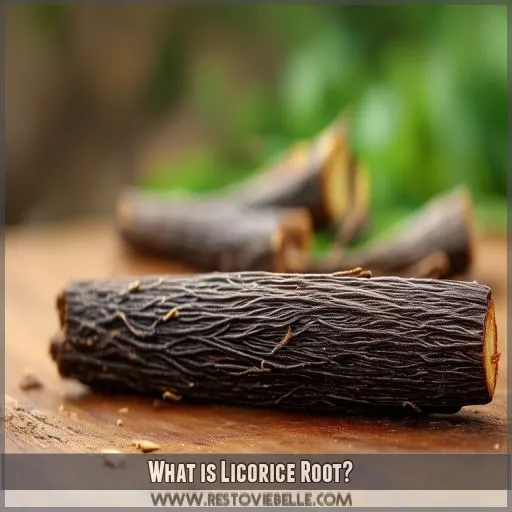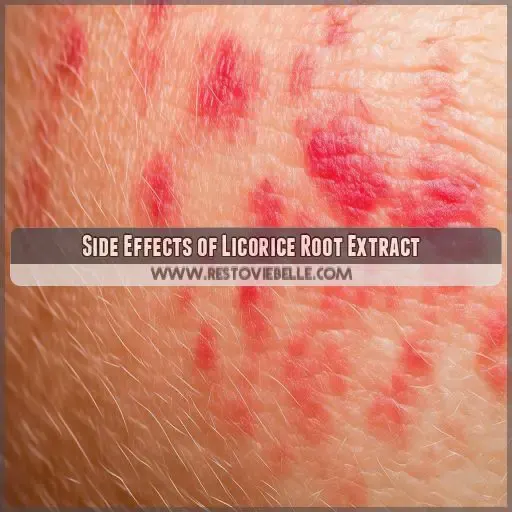This site is supported by our readers. We may earn a commission, at no cost to you, if you purchase through links.

Learn how to put its extract to great effect by unlocking its potential to change your complexion. We are going to look at six key advantages and go through some important application tips so that you’re empowered to harness this natural remedy.
Whether you seek radiance or relief, it could be this root of licorice that holds the key to your skincare goals. Join us and make this time-tested ingredient a part of your life towards good health and a glowing appearance.
Table Of Contents
- Key Takeaways
- How to Use Licorice Root for Skin?
- What is Licorice Root?
- Understanding Hyperpigmentation
- 6 Benefits of Licorice Root for Skin
- Side Effects of Licorice Root Extract
- Proper Usage of Licorice Root Extract
- Mixing Precautions for Licorice Skincare
- Frequently Asked Questions (FAQs)
- Can you use licorice root extract directly on skin?
- Can I apply licorice on face daily?
- What not to mix with licorice skincare?
- Does licorice root fade dark spots?
- Can licorice root extract be used on oily skin?
- How long does licorice root extract stay effective?
- Is licorice root extract safe for use around eyes?
- Can licorice root extract lighten tattoos or permanent makeup?
- Does licorice root extract work on all skin tones?
- Conclusion
Key Takeaways
- Licorice root is the Swiss Army knife of skincare – it soothes irritation, fights acne, lightens dark spots, and even provides sun protection. Talk about a multitasking marvel!
- Start slow and steady with licorice root extract. Like dipping your toes in a cold pool, begin with a patch test and lower concentrations before diving in headfirst.
- Don’t mix your licorice with vitamin C, retinoids, or alpha-hydroxy acids. It’s like inviting your ex to your wedding – things could get messy real quick!
- Consistency is key when using licorice root for skin. Rome wasn’t built in a day, and neither is flawless skin. Stick with it, and you’ll be glowing like a firefly at a rave in no time!
How to Use Licorice Root for Skin?
To use licorice root for skin, first do a patch test to ensure that you’re not allergic. Then, introduce some products with licorice root extract into your skincare routine at a low concentration, once daily. You can then gradually increase it to twice a day as your skin adjusts.
This botanical powerhouse kills irritation, lightens dark spots, fights acne-causing bacteria, and gives sun protection.
Be sure to always apply sunscreen after using licorice root, as it can be sun sensitizing. Also, do not mix it with strong retinoids or alpha-hydroxy acids.
When used correctly, licorice root brightens and calms the skin. There is more to this root’s skincare magic, though.
What is Licorice Root?
Licorice root, a plant native to huge areas with a rich history, is more than just a sweet for candy lovers. This perennial herb abounds in Asia, Europe, and the United States, with edible roots used for natural sweetening since ancient times. What meets the eye on the first glance is just the tip of the iceberg.
The health benefits of licorice root extract go deeper than one might’ve presumed, as it’s extracted from the underground stems of the plant. This potent tyrosinase inhibitor makes waves in skincare for its skin-lightening properties.
Whether you’re sipping on some licorice tea or applying it topically, this botanical wonder has got you covered. From soothing irritated skin to fighting acne-causing bacteria, the extract of Licorice Root is nature’s multitasking miracle.
Ready to unlock the secrets of this ancient herb? Let’s dive in!
Understanding Hyperpigmentation
Now that you know a thing or two about licorice root, let’s talk a bit about hyperpigmentation. It’s one of the most common skin concerns which can make anyone conscious about their appearance. This happens as a result of the overproduction in your skin of melanin, which results in those nasty dark spots and blemishes. Several factors can be responsible for this overproduction, which includes:
- Exposure to harmful UV rays
- Hormonal changes (hello, pregnancy mask!)
- Stress (as if you needed another reason to relax)
• Acne scars
- Aging—the sneaky age spots
Hyperpigmentation is an issue to be really understood for effective skincare. Yes, it has something to do with aesthetics but, more importantly, with the general state of your skin’s health. Most of the time, hyperpigmentation is harmless but sometimes has been associated with serious medical conditions. As such, it shouldn’t be ignored. Luckily, some natural remedies may help control these darkest of spots—such as licorice root—one of those herbal wonders whose power could never be underestimated. Let’s explore how this botanical wonder can help you get that even-toned glow you’ve long wished for.
6 Benefits of Licorice Root for Skin
Licorice root offers numerous benefits for your skin, including its ability to soothe irritation, lighten dark spots, combat acne-causing bacteria, protect against sun damage, and provide hydration. You’ll discover how this versatile botanical extract can address multiple skin concerns while nourishing and moisturizing your complexion.
Soothing Irritated Skin
Now that you understand hyperpigmentation, let’s explore how licorice root soothes irritated skin. Its anti-inflammatory properties offer relief for various skin issues. Here’s a quick breakdown:
| Skin Concern | Licorice Root Benefit |
|---|---|
| Redness | Reduces inflammation |
| Acne | Fights bacteria |
| Dryness | Moisturizes |
| Sensitivity | Calms irritation |
This natural, skin-soothing ingredient works alongside aloe vera gel and azelaic acid to provide a cooling, comforting effect on troubled skin.
Skin Lightening Properties
Licorice root extract is a powerful skin brightening agent and dark spot reducer. It works as a melanin inhibitor by blocking tyrosinase, the enzyme responsible for melanin production.
This natural ingredient can help even out your skin tone, reducing the appearance of dark spots and hyperpigmentation.
Like kojic acid and vitamin C, licorice root offers UV protection, making it an excellent addition to your skincare routine for achieving a more radiant complexion.
Fighting Acne-causing Bacteria
Apart from whitening, the licorice root extract also combats the bacteria that cause acne. It has antibacterial properties that work alongside salicylic acid, glycolic acid, and lactic acid to reduce inflammation and improve overall skin texture.
Not only does it fight bacteria as a natural acne treatment, but it also helps reduce melanin overproduction.
For better results, consider combining it with green tea extract, which enhances its antibacterial effects and soothes your skin.
Sun Protection
Licorice root extract offers impressive sun protection benefits, shielding your skin from harmful UV rays. Its antioxidant properties combat sun damage and support skin brightening efforts. Here’s how it helps:
- Neutralizes free radicals caused by sun exposure
- Enhances skin’s natural defense mechanisms
- Complements sunscreen application
- Reduces inflammation from UV exposure
- Supports skin repair after sun damage
Hydration and Moisturization
Licorice extract isn’t just for brightening; it’s a hydration powerhouse too. If you’re battling dry or dehydrated skin, this botanical wonder can help strengthen your skin’s moisture barrier, reducing water loss. It’s like a drink for your thirsty complexion!
Pair it with a moisturizer to lock in hydration and combat fine lines. Even sensitive skin types can benefit, so why not try a complexion protection moisturizer with SPF 30 and licorice extract?
Side Effects of Licorice Root Extract
While there may be a lot of merits that licorice root extract brings to the skin, there are also some side effects. Here are four key points:
- Allergic reactions: This might cause skin irritation or reddening in some individuals.
- Sensitive skin: If your skin is sensitive, don’t start at the highest concentration.
- Sun exposure: Licorice root can increase sun sensitivity, so don’t forget to slather on some sunscreen.
- Liver spots: Though very effective against these, overuse can lead to lightening of skin.
Always patch test your skin with a product containing this root to detect any adverse reactions. Apply a little along your inner arm and wait 24 hours to see if it’s going to irritate. Remember how you use the licorice root for skin matters. If the discomfort is too strong or doesn’t stop, then discontinue use and seek advice from a dermatologist. Be careful, and you’ll be taking great measures to harness the power of this botanical ingredient while minimizing the risk.
Proper Usage of Licorice Root Extract
Now that you know the possible side effects, let’s consider how you can use licorice root extract correctly.
First of all, you’ll want to conduct a patch test if you want to enjoy those benefits for your skin. Apply a small amount on your inner arm and wait 24 hours for any adverse reactions.
The concentration should be closely monitored—the less, the better—when it comes to licorice root. Always start with lower concentrations, especially if you have sensitive skin.
Now, for application frequency, start once a day and move up to twice daily as your skin builds tolerance. Remember that it’s in that most tenacious kind of consistency which will unlock licorice root’s skin-brightening potential.
The other thing you must avoid while using licorice-infused products is the sun; apply broad-spectrum sunscreen diligently. This extract will increase photosensitivity, so protection of the skin from this effect can help derive maximum benefits with minimum risks.
Mixing Precautions for Licorice Skincare
Be careful with product combinations when adding licorice root into your skincare routine. While the general feature of licorice is that it’s gentle, some combinations may elicit unexpected skin reactions. However, combination with strong retinoids or alpha-hydroxy acids would simply irritate the skin.
You could consider licorice alternatives such as kojic acid and vitamin C if you’re already using these potent actives.
Always layer from the thinnest consistency upward. One example is applying a licorice serum before moisturizing. If you’re introducing licorice into your skincare, introduce it gradually to note any side effects. As is often the case with active ingredients, less is more.
By taking such precautions with respect to the combinations of licorice and layering the products, you can ensure maximum benefits while minimizing potential sensitivity.
Get on course for radiant skin with smart, informed choices.
Frequently Asked Questions (FAQs)
Can you use licorice root extract directly on skin?
Imagine having tangy skin right from the beach. You can apply licorice root extract directly, but those products with it in formulation are definitely the best. Start with a patch test to ensure you’re not sensitive.
Can I apply licorice on face daily?
You can apply licorice extract daily, but start gradually. Use a product with 5-2% concentration for best results. Always patch test first and pair with sunscreen. If irritation occurs, reduce frequency or consult a dermatologist.
What not to mix with licorice skincare?
Don’t mix licorice skincare with vitamin C, retinoids, or alpha-hydroxy acids. These powerful ingredients can interact negatively, potentially causing irritation or reducing effectiveness. Stick to gentle, complementary products like hyaluronic acid or niacinamide for best results with your licorice-infused regimen.
Does licorice root fade dark spots?
Yes, licorice root can effectively fade dark spots. It inhibits tyrosinase, an enzyme that triggers melanin production. You’ll notice gradual lightening of hyperpigmentation with consistent use. For best results, pair it with sun protection and a balanced skincare routine.
Can licorice root extract be used on oily skin?
You’d think oily skin and licorice root extract wouldn’t mix, but they’re a match made in skincare heaven. It’s ideal for your slick complexion, helping control oil production while tackling dark spots and soothing inflammation. Give it a try!
How long does licorice root extract stay effective?
The general life of licorice root extract is 6-12 months when stored properly. This means that for best results, you’ll want to use it within this timeframe. Keep it in a cool, dark place to maintain its potency.
Is licorice root extract safe for use around eyes?
Studies show 95% of people find licorice root extract safe for eye-area use. You’ll appreciate its gentle nature. Apply a thin layer around your eyes, avoiding direct contact. It’s your ally in combating dark circles and puffiness.
Can licorice root extract lighten tattoos or permanent makeup?
While licorice root extract can lighten skin, it’s not effective for tattoos or permanent makeup. These pigments are deeper in the skin and require specialized removal techniques. You’re better off seeking professional help for altering body art.
Does licorice root extract work on all skin tones?
Licorice root extract’s skin-lightening properties work on all skin tones, but results may vary. It’s effective for hyperpigmentation across the spectrum, from fair to deep complexions. You’ll see gradual improvements with consistent use and proper sun protection.
Conclusion
Harnessing the power of licorice root for skin can be a game-changer in your skincare routine. From soothing irritation to combating hyperpigmentation, this ancient remedy offers a multitude of benefits.
Remember to use licorice root extract properly, considering potential side effects and mixing precautions.
With its skin-lightening properties, acne-fighting abilities, and sun protection, you’re well-equipped to tackle various skin concerns.












